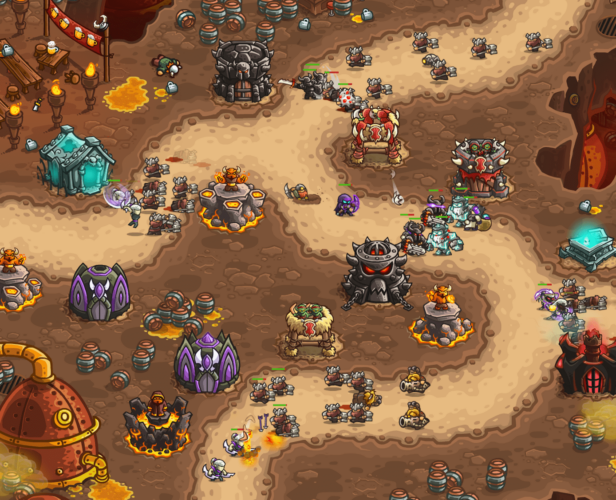Category
Data & Analytics
#Data & Analytics
New Report by Adjust and Facebook Reveals Opportunities for Developers
This month, Adjust has teamed up with Facebook to analyze the mobile app market and produce The Mobile App Growth Report. The report digs into the top trends across the industry, focusing on where there has been the most growth, and highlighting trends in emerging markets. And it looks like good news for game developers. Games keep going strong Growing like skeletons out of a mob spawner, games are the top-ranking industry this year. It looks like the surge of activity we’ve seen the last few years is showing no sign of slowing down and that there are more and more people turning to games for entertainment. Hyper-casual games push the industry forward It’s worth noting that Adjust believes that a big part of this growth is due to the hyper-casual genre, which makes sense. We’ve seen that over lockdown...
#Data & Analytics
The Metrics Behind Successful Tower Defense Games
Get ready to plan your layout, as you’ve got waves upon waves of metrics coming at you. We’ve been taking a gander at Tower Defense games in our latest report, so let’s look at what the perfect set up is when developing yours. If you’d like to jump straight into the stats, download the full report. And, if you’re a keen strategist, you can dive even deeper with Benchmarks+. What’s a Tower Defense game? It’s a strategic genre where the player needs to defend their territory from increasingly large waves of enemies. Usually, the waves of mobs swarm down a path and the player must line it with traps and attacks, usually towers. The key is that the player doesn’t typically control these towers themselves. They automatically fire when an enemy approaches. Why are they popular? Tower Defense combines elements...
#Data & Analytics
Left or Right? How Data Warehouses Make it Easy to Make Decisions
Deciding between two different courses of action is perhaps the hardest part of running any business. Recently we wrote about how data warehouses can give you insights, trends and information. Everything you need to make informed decisions. But what sort of decisions do they help with? How do you actually take that insight and make practical choices? In this article, we’re going to talk through nine decisions you might need to make. And how a data warehouse can help. Why do studios and publishers use data warehouses? Most hit studios and publishers have a portfolio of games. A data warehouse brings together the data from across them all and converts it into a format they can search through. With more data, they can spot trends. Knowing the trends, they can fix bugs, optimize their ads, see which ideas perform the...
#Data & Analytics
What is a Data Warehouse and Why do Hit Studios use them?
The other day, I had to venture into the tangled mess of my cable bag. No matter how organized I think I’m being – neatly wrapping cords around their plugs and keeping everything separate – whenever I leave the bag alone for five minutes, it all turns into a Gordian knot by the time I return. It’s infuriating. I really should get a nice box, and make it easy to find what I need. It struck me how similar that feeling is to juggling data from a bunch of different games. Lots of tools and data, all in a mess. But thankfully, you can get a data warehouse to fix the problem. Data warehouses make it much easier to search through and find what you need, reveal insights, and help you combine all those different sources. They’re an essential part...
#Ads & Monetization
The Metrics That Make for a Great Match 3 Game – And How to Reach Them
The match 3 genre has given us some of the most successful, long-running games of all time. With Benchmarks+ we can see what metrics make the best match 3 games successful. We recently updated our Benchmarks+ tool to include 25 sub-genres – one of which is ‘match 3 puzzle’. So now that we can see this classic, much-loved sub-genre in all its multi-metric magnificence, let’s take a look at what a successful match 3 game looks like. To start with: what is a match 3 game? Pretty much any game that challenges you to put matching objects together can be classified as a match 3 game. They started back in the eighties, with games like Tetris, Chain Shot! and Puzznic. In the 2000s, there was Candy Crush and Bejeweled Blitz. And more recently, there are popular titles like Ticket to...
#Data & Analytics
iOS14 and IDFA Changes: What It Means for Mobile Developers
We recently held a webinar to discuss the changes we can expect from iOS14 and rule changes to IDFA that are due in early 2021. It was an interesting, lively discussion with GameAnalytics and Tenjin, answering some of the developers’ and publishers’ most pressing questions. We’ve had some time to reflect on all the topics we discussed. Here are our takeaways: So what is IDFA? IDFA stands for ‘identifier for advertisers. It allows advertisers to follow users through the experience – from seeing the ad in another app and then actually ending up in your app. Apple first introduced it and it’s exclusive to iOS Devices. But there’s a similar system on Android. Users do have the option to disable IDFA, but it’s always on by default. And what’s changing? From some point in early 2021, the default for IDFA...
#Data & Analytics
Why Painted Door Tests are a Secret Weapon in Game Development
Have you ever launched a new feature that you were confident would succeed and be game-changing? Not only did your gut tell you it was a good idea, but you were able to back it up with user research? Then, when you finally launched, you found the new feature made very little difference. Perhaps users didn’t notice it, or they just didn’t care about it in actual game play. All the time, money, and resources you put into it could have been spent elsewhere. This has happened to me countless times, and it’s why we at Solitaired now take a data-driven approach towards understanding what new features we should work on. A $1M mistake I learned the hard way that both my instinct and consumer research could be wrong. Before getting into the gaming space, I had run an educational...
#Data & Analytics
Making Casual Games in a COVID19 World – Post Webinar
If you’ve missed our webinar, have a question for the speakers, or want to find the videos or links to the resources that our speakers mentioned, you’re in the right place. If you fancy the TL:DR version, head to our blog here. Below you can find the webinar recordings and links to related resources and if you have any questions for the speakers or any feedback on our next webinars, use the form to the right and we will get your query to the right people. Here are the recordings: 2020 Gaming KPIs in Review – GameAnalytics GameAnalytics Ioana Hreninciuc, CEO at GameAnalytics, presents insights on key metrics, including retention, ARPDAU, Session Length, CPI, and more. Watch the recording Quarantined World: Reaching the At-Home Mobile Gamer Adjust Stephanie Pilon, Global Director of Product & Field Marketing at Adjust, explains...
#Ads & Monetization
Why AdOps and LTV are Essential to Your Softlaunch
The term ‘live ops’ is an industry-standard. Most large and mid-sized studios and publishers have a department that remotely configure their games, whether that’s localization, in-game events like flash sales, or daily bonuses. So what is ad ops? And where does it fit in? Well, before we can explain that, we need to explain Lifetime Value (LTV). Optimize your LTV at softlaunch In games that rely on ads to make money, it’s usually the user acquisition and monetization teams who are fighting to increase LTV. They’ll make the Cost Per Install (CPI) 1 cent cheaper or get the player to watch one more teeny tiny ad. All to creep up their profit, cent by cent. But developers almost always optimize their ads after they launch their game – it’s already live and getting thousands of downloads a day. Leaving it...
#Case study
How the devs behind Crossy Road and Shooty Skies became mobile masters
Never spend too long creating a game “For Crossy Road, we made it in 12 weeks, but we actually set out to make it in six,” says Sum. “That all meant that, if it didn’t go well, we hadn’t wasted all that much time. You just don’t know what’s going to happen on mobile. If you take six months to make a game, everything might have changed by the time it comes out.” Finding a team that gels “Every member of the team has their own skills that complement each other,” Sum is keen to note. “Matt Ditton handles a lot of the business side, but he’s a technical programmer too. Whereas Ben is really technically awesome and led the development of Shooty Skies.” Even though they now have a bigger team, Sum said his goal was to create “something...
#Data & Analytics
2020 in Metrics: Understanding Casual and Hypercasual Gaming Markets
2020’s been a year like no other. Casual and hypercasual gaming has fared better than most industries – overall playtime has been consistently up by around 15% on previous years. But when all of our usual social norms have been upended by global lockdowns, how do we make sense of the player metrics we rely on? I recently hosted a webinar on this topic. Using Benchmarks+ from GameAnalytics, I pulled some of the most telling player data from the first eight months of 2020. I dived into the key metrics like retention, session lengths, and playtime. And I did a deep dive specifically on hypercasual – comparing the different app stores and regions. Here’s a summary of the trends I found that will be most useful for developers to understand. The differences between iOS and Android It’s important not to...
#Data & Analytics
Lessons from Lockdown: Making Casual Games in a Covid-19 World
In September we ran the first webinar in our Toolbox series: making casual games in a Covid-19 world. Joined by our friends at Adjust and TopOn, we covered what we’ve spotted, how to grow your casual game and how to advertise during the pandemic. Don’t worry if you missed it. You can catch the recordings and read up on the talks in this blog. It’s been an odd few months. Over that time, we’ve noticed a dramatic shift in the gaming industry: we’ve never seen so much playtime, traffic is at an all-time high and some countries have really surprised us. So we thought it’d be worth sharing the key metrics and banding together with Adjust and TopOn to give you some advice on how to make sure it’s your game beneath those idle thumbs. The webinar had three main...
#Data & Analytics
What’s Their Secret? 4 Steps Successful Publishers Take to Find Hit Games
We’ve all asked ourselves this question: “How do publishers release hit game after hit game? How do they know which ones are going to be successful?”. Now, we don’t know all the ingredients to their secret sauce (be it their relationships with developers, network, or UA tools). But what we can do is go over what we know, and what we do best. Data. Data is a crucial part in finding the next big hit. But sifting through tens or hundreds of prototypes at one time is in itself, a massive challenge. Especially when your team is small. Step 1: Find more prototypes to evaluate In an ideal world, you’d open up your laptop and see key metrics (like day 1 retention, day 7, and Playtime) for a bunch of new games that were submitted yesterday. Well, you can. And...













